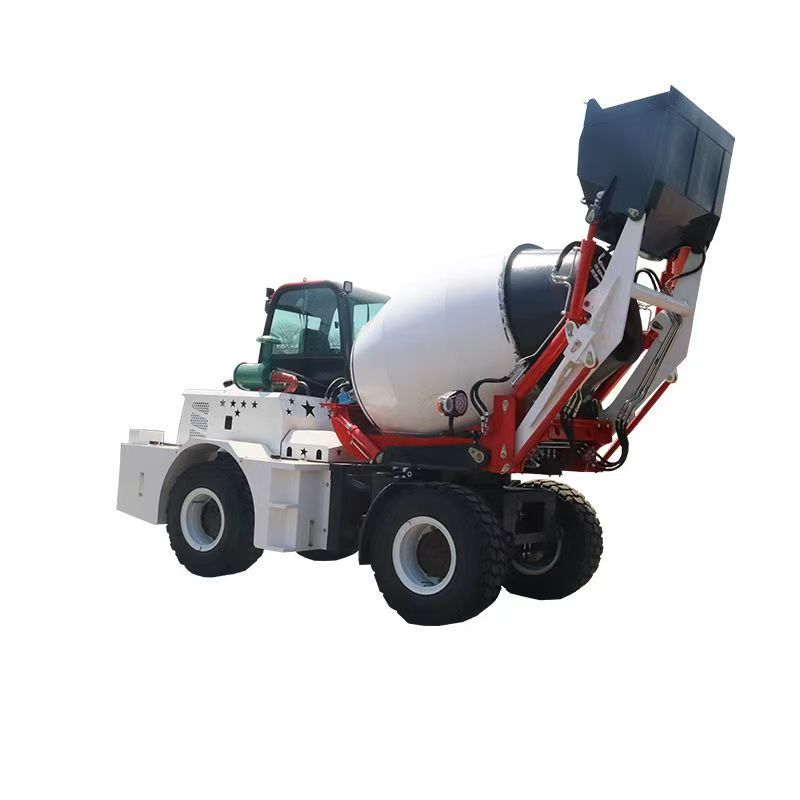A concrete mixer truck is a specialized vehicle used for transporting ready-mixed concrete, widely applied in construction engineering and other fields. The following details its usage aspects in multiple dimensions:

I. Pre-Use Preparations
Vehicle Inspection
- Appearance and Components: Check for scratches, oil leaks on the vehicle body, ensure tire pressure is normal, and verify that the tank, feeding hopper, discharge chute, etc., are intact without deformation or blockage.
- Operation System: Test whether functions such as forward/reverse rotation control of the mixing tank and discharge speed adjustment are sensitive, and ensure the hydraulic system pressure meets standards.
- Safety Devices: Confirm that safety equipment like the braking system, turn signals, reversing camera, and warning lights are working properly.
Concrete-Related Preparations
- Understand the grade (e.g., C30, C40) and slump requirements of the transported concrete, and adjust the tank rotation speed as needed (typically 2-4 revolutions per minute during transportation to prevent concrete segregation).
- Check if the inside of the tank is clean. If there is accumulated water or residual concrete, clean it in advance to avoid affecting the performance of the new concrete.
II. Operation Specifications During Transportation
Loading Operation
- Park the mixer truck at the designated loading position, adjust the height of the feeding hopper, and align it with the outlet of the concrete mixer.
- During loading, keep the tank rotating forward at a low speed (about 6-10 revolutions per minute) to ensure the concrete enters the tank evenly and avoid material accumulation or splashing.
- After loading, check if the feeding hopper is tightly closed to prevent material leakage during transportation.
Transportation Driving
- Accelerate slowly when starting, avoid sudden braking, and prevent concrete segregation in the tank due to inertial impact.
- During driving, maintain the tank at a low-speed rotation of 2-4 revolutions per minute to keep the concrete in a continuous mixing state and prevent solidification.
- Avoid high-speed cornering or bumpy roads. If the road condition is poor, reduce speed and, if necessary, pause the tank rotation to prevent material spillage.
Emergency Handling En Route
- If the transportation time exceeds the initial setting time of the concrete (usually no more than 2 hours), communicate with the construction site in advance to add a retarder or take other measures.
- In case of abnormal noise, oil leakage, or hydraulic system failure in the tank, stop immediately for inspection, and resume driving only after troubleshooting.
III. Discharge and Post-Discharge Maintenance
Discharge Operation
- After arriving at the construction site, park the vehicle steadily, apply the handbrake, and ensure the body is stable.
- Adjust the angle of the discharge chute to align with the discharge position (such as the pump truck hopper or pouring formwork), start the tank in reverse rotation (speed about 6-8 revolutions per minute), and begin discharging.
- During discharge, observe the concrete condition. If issues like segregation or caking occur, promptly communicate with technicians for handling.
- After discharge, continue rotating the tank for 1-2 minutes to (eject) residual concrete and avoid material accumulation.
Cleaning and Maintenance
- Immediately rinse the feeding hopper, discharge chute, and the exterior of the tank with clean water after discharge to prevent concrete solidification and residue.
- Regularly perform deep cleaning of the tank interior (e.g., after every 5-10 transports) by adding an appropriate amount of water and gravel, rotating the tank at high speed for 10-15 minutes, then discharging the wastewater.
- Check the levels of hydraulic oil and gear oil, add them in a timely manner if insufficient; lubricate rotating components (such as bearings and couplings) to ensure smooth equipment operation.
IV. Safety Precautions
- Personnel Safety: During discharge, prohibit personnel from standing under the discharge chute or near the tank to avoid injuries caused by material falling or tank rotation.
- Equipment Safety: Overloading is strictly forbidden (load according to the vehicle's approved weight) to prevent tank deformation or accidents caused by vehicle center of gravity shift.
- Environmental Safety: Avoid concrete spillage during transportation. If leakage occurs, clean it up promptly to prevent road pollution; washing wastewater must be discharged into designated sedimentation tanks, and random discharge is prohibited.
V. Key Points for Special Scenarios
- Low-Temperature Environment: During winter transportation, insulate the tank (e.g., add an insulating layer) and, if necessary, add antifreeze to prevent concrete from freezing.
- High-Temperature Environment: In summer, shorten transportation time, avoid direct sunlight on the tank, and appropriately reduce the tank rotation speed to minimize concrete temperature rise.
- Slope Discharge: When discharging on a slope, fix the wheels with stones or wooden blocks to prevent vehicle sliding; ensure stability when adjusting the discharge chute angle.
VI. Common Faults and Solutions
| Fault Phenomenon | Possible Causes | Solutions |
|---|---|---|
| Tank fails to rotate | Hydraulic system failure, motor damage | Check hydraulic oil pressure, repair or replace the motor |
| Slow discharge speed | Insufficient tank rotation speed, outlet blockage | Adjust the speed, clean residual concrete from the outlet |
| Concrete segregation | Excessive transportation time, abnormal rotation speed | Shorten transportation time, check tank rotation status |
| Oil leakage | Loose pipe joints, aged seals | Tighten joints, replace seals |
The rational use of concrete mixer trucks not only ensures concrete quality but also improves construction efficiency and extends equipment life. It is necessary to strictly follow operation procedures and conduct regular maintenance to keep the equipment in good condition at all times.





